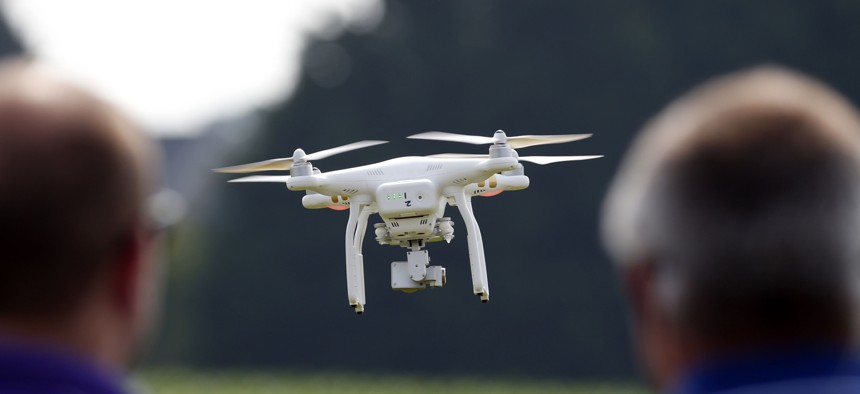
Alex Brandon/AP
America’s Top Drone Company Just Teamed Up with a Chinese Industry Titan
Less than a year ago, DJI knocked the California-based 3D Robotics out of the consumer market. Now, the US firm has turned to software — and a partnership with its vanquisher.
It’s like the drone equivalent of IBM partnering with Apple .
Today (Aug. 1), 3D Robotics announced a partnership with DJI, where the California-based company will integrate its site-scanning software with the Chinese firm’s drones.
Once upon a time, all the way back in 2015 , 3D Robotics (3DR) was one of the most promising new consumer-drone companies, touted as one of the main companies, alongside DJI, Parrot, and Yuneec, that would bring small personal drones into the mainstream. Chris Anderson, the company’s co-founder and Wired’s former editor in chief, quit his post at the magazine—after publishing one last cover story about the future of drones—to concentrate on 3DR in 2012. But 3DR struggled to produce its flagship drone, the Solo, at scale, then suffered weak holiday sales; in the process, 3DR burned through the majority of the nearly $100 million it had received in venture capital, laid off 150 people, and decided that it was going to leave the hardware market to concentrate entirely on software for commercial drones.
“We were the American DJI,” Anderson told Quartz, of the company’s brand-name recognition in the nascent drone market. “We went head to head with them in consumer—now in the commercial era, we are partnering with them.”
3DR will give DJI drones its Site Scan technology. A drone with a high-resolution camera running the Site Scan software enables those working at every stage of a construction project to keep track of the design they’re working towards. An architect can use it to scan the surface of where their building will be going and use that to create an accurate model from which to design their structure; engineers can use it to make sure they’re building exactly as intended, and to catch any deviations from the original design models. “Building cost overruns tend to happen because of the deviation between what was supposed to happen and what did happen,” Anderson said.
In the future, this sort of technology could be applied to any industry where objects need to be surveyed—a farmer ensuring his crops are coming in as intended, for example, or transportation authorities checking up on the health of their infrastructure. But for now, Anderson and his team are focused on construction.
Want to keep owners, subcontractors, and your team aligned? Use drones to send progress updates from the sky: https://t.co/FJZbhLKi2G pic.twitter.com/WbgEJn9gUu
— 3D Robotics (@3DRobotics) July 31, 2017
Anderson says it made sense for his team to bring their software to the most popular drone manufacturer on the market. Much as Apple helped invent and dominate the high-end smartphone market, DJI has been an innovator and now has become the market leader in top-of-the-line drones. Through a massive research and production operation in Shenzhen, DJI has managed to release new products at such a fast rate that it’s kept most other companies fighting a price war in a race to the bottom. In the last year, DJI has released three new consumer drones, each of which has been considered the best that you can buy at their respective price points. In the same time, GoPro, the action-camera company, delayed, recalled, and re-released its first drone, that was costlier and had fewer features than DJI’s two most-recent drones.
Anderson, an early acolyte for commercial and consumer drones, told Quartz he stunned by how quickly the consumer drone market was commoditized by Chinese manufacturers. “Hardware didn’t remain hard as long as I expected,” he said. “The speed at which China picked it up was just extraordinary.”
DJI’s ability to produce high-quality drones effectively knocked 3DR out of the drone market after one product. The 3DR Solo competed against DJI’s Phantom 3 at roughly the same price and feature set, but after reports of 3DR drones drifting away (or being more difficult to pilot than expected ) and recalls , the company seemed to throw in the towel. There was no Solo 2, whereas there was indeed a Phantom 4 (though DJI does have its own quality issues to contend with).
Anderson holds no animosity toward DJI. “Working with DJI, it was an easy decision,” he said, adding that he considers his company “a core tech company,” rather than a manufacturer.
In any case, today’s announcement is another sign the drone industry may end up mirroring the early smartphone market: DJI, like Apple, has cornered almost the entirety of the top of the market, with most other players focusing on lowering costs as much as possible, much like the early Android phones. It wasn’t really until Samsung got involved and managed to bring a higher level of quality to smartphone development that Apple was knocked off its perch. We don’t really have a sense for the size of the drone market right now—there are no easy figures to be found, but analysts believe them to be selling in the high hundreds of thousands per year—and so we don’t really know what the market will look like in the end.
For now, at least, “from a consumer perspective, they’ve got close to a monopoly,” Anderson said of DJI.